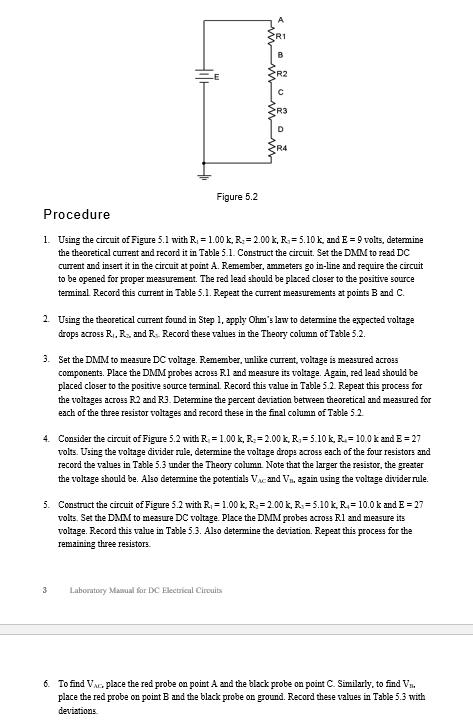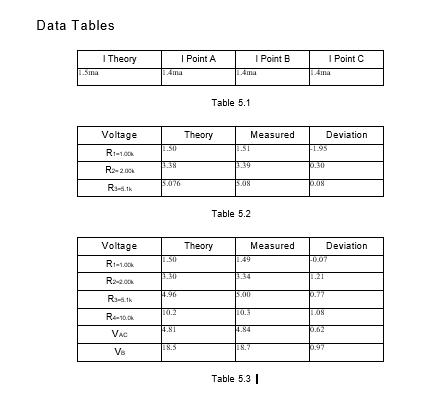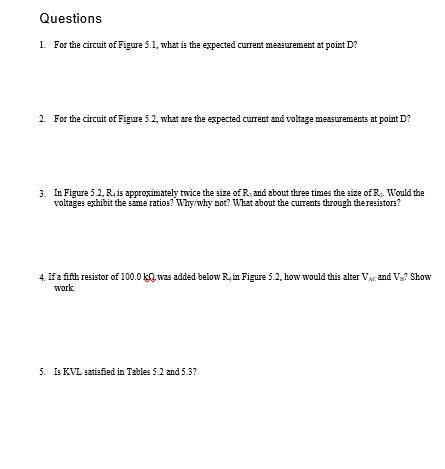Answered step by step
Verified Expert Solution
Question
1 Approved Answer
The focus of this exercise is an examination of basic series DC circuits with resistors. A key element is Kirchhoffs Voltage Law which states




The focus of this exercise is an examination of basic series DC circuits with resistors. A key element is Kirchhoffs Voltage Law which states that the sum of voltage rises aroumd a loop must equal the sum of the voltage drops. The voltage divider rule will also be investigated. Theory Overview A series circuit is defined by a single loop in which all components are arranged in daisy-chain faskion The current is the same at all points in the loop and may be found by dividing the total voltage source by the total resistance. The voltage drops across any resistor may then be found by multiplying that curent by the resistor value. Consequently, the voltage drops in a series circuit are directly proportional to the resistance. An altemate technique to find the voltage is the voltage divider rule. This states that the voltage across any resistor (or combination of resistors) is equal to the total voltage source times the ratio of the resistance of interest to the total resistance. Equipment model: model: (1) Adjustable DC Power Supply (1) Digital Multimeter (1) 1 k0 (1)22 ka (1) 3.3 k0 (1) 6.8 kO Schematics A B R1 PR2 D. R3 Figure 5.1 A R2 R3 D R4 Figure 5.2 Procedure 1. Using the circuit of Figure 5.1 with R, = 1.00 k, R; = 2.00 k, R. = 5.10 k, and E = 9 volts, determine the theoretical current and record it in Table 5.1. Construct the circuit. Set the DMM to read DC current and insert it in the circuit at point A. Remember, ammeters go in-line and require the circuit to be opened for proper mezsurement. The red lead should be placed closer to the positive source terminal Record this current in Table 5.1. Repeat the current measurements at points B and C. 2 Using the theoretical current found in Step 1, apply Ohm's law to determine the expected voltage drops 2cross R., R, and R. Record these values in the Theory column of Table 5.2. 3. Set the DMM to measure DC voltage. Remember, unlike current, voltage is measured acroas components. Place the DMM probes across Rl and measure its voltage. Again, red lead should be placed closer to the positive source terminal. Record this value in Table 5.2 Repeat this process for the voltages across R2 and R3. Determine the percent deviation between theoretical and measured for each of the three resistor voltages and record these in the final column of Table 52 4. Consider the circuit of Figure 5.2 with R = 1.00 k, R. = 2.00 k, R, = 5.10 k, R.= 10.0 k and E =27 volts. Using the voltage divider rule, determine the voltage drops across each of the four resistors and record the values in Table 5.3 under the Theory column. Note that the larger the resistor, the greater the voltage should be. Also determine the potentials Vx. and Vn, again using the voltage divider rule. 5. Construct the circuit of Figure 5.2 with R, = 1.00 k. R. = 200 k, R. = 5.10 k, R. = 10.0 k and E = 27 volts. Set the DMM to measure DC voltage. Place the DMM probes across R1 and measure its voltage. Record this value in Table 5.3. Also determine the deviation. Repeat this process for the remaining three resistors. 3 Laboratory Manual for DC Electrical Cirouits 6. To find Va. place the red probe on point A and the black probe on point C. Similarly, to find Vn. place the red probe on point B and the black probe on ground. Record these values in Table 5.3 with deviations Data Tables I Theory I Point A Ama I Point B I Point C .Sma 1Ama 4ma Table 5.1 Voltage Theory Measured Deviation EST F1.95 R1-100k 18.38 1.39 0.30 15.076 5.08 Table 5.2 Voltage Theory Measured Deviation 1.49 0.07 Rt-1.00k 1.34 4.96 5.00 p.77 R3- th 10.2 10.3 Re-10.0k 4.81 4.84 0.62 VaC 8.5 8.7 0.97 Vs Table 5.3 | Questions 1. For the circuit of Figure 5.1, what is the expected current measurement at point D? 2. For the circuit of Figure 5.2, what are the expected current 2nd voltage measurements at point D? 3. In Figure 5.2, R, is approximately twice the size of R. and about three times the size of R. Would the voltages exhibit the same ratios? Why/why not? What about the currents through theresistors? 4. Ifa fifth resistor of 100.0 kQ was added below R, in Figure 5.2, how wvould this alter VM: and V? Show work. 5. Is KVL satisfied in Tables 5.2 and 5.3?
Step by Step Solution
★★★★★
3.50 Rating (157 Votes )
There are 3 Steps involved in it
Step: 1
1 Since the circuit is series combination of resistors The current is same at any point in the serie...
Get Instant Access to Expert-Tailored Solutions
See step-by-step solutions with expert insights and AI powered tools for academic success
Step: 2

Step: 3

Ace Your Homework with AI
Get the answers you need in no time with our AI-driven, step-by-step assistance
Get Started


